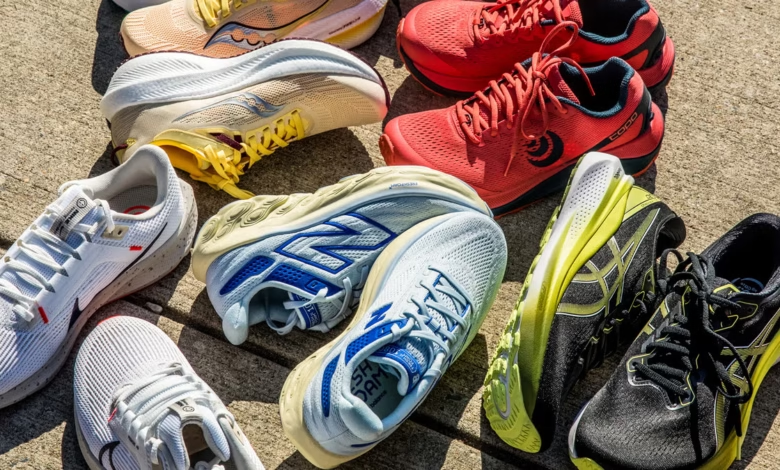
If you have flat feet, shopping for running shoes can feel like navigating a minefield: too-soft midsoles that collapse under load, narrow toe boxes that jam your toes, or shoes that promise “stability” but feel clunky. This guide—written for real miles and real people—breaks down the best running shoes for flat feet 2025, what to look for, and a handful of top picks that actually help you run more comfortably.
Why flat feet change everything
Flat feet (low arches) often come with a tendency to overpronate—your foot rolls inward more than ideal when it strikes the ground. That inward roll changes how forces travel up your ankle, knee and hip, so the right shoe needs to stabilize, control excessive motion, and still feel comfortable for your usual miles. Not everyone with flat feet needs a heavy motion-control shoe; many do better with stability shoes that guide the foot without forcing it into an unnatural position. Trusted reviewers and shoe testers continue to put stability trainers front and center for flat-footed runners in 2025. Runner’s World+1
What to look for in 2025 (quick checklist)
- Firm medial support or GuideRails-style stability — helps prevent excessive inward roll without being rigid. #1 Athletic Shoe Review Site
- Broad, stable platform and roomy toe box — lets toes splay and prevents pressure points. #1 Athletic Shoe Review Site
- Moderate to firm midsole density — too soft = collapse; too hard = discomfort. Aim for a balance.
- Good heel counter and lockdown upper — keeps the foot secure so the support can do its job.
- Try with your orthotics (if used) — many flat-footed runners use custom or over-the-counter insoles; bring them to the fitting.
Top picks for running shoes for flat feet 2025
Below are models repeatedly recommended by experts and testers this year. I’ve focused on shoes that combine stability with comfort—so you can log miles without resentment.
1. Brooks Adrenaline GTS 25 — the dependable daily stabilizer
Why it stands out: Brooks’ GuideRails support system has been a go-to for runners who need support but don’t want a heavy motion-control shoe. The Adrenaline remains a top pick in lab tests and real-world reviews for providing a centered ride with enough cushioning for daily mileage. Reviewers praise the updated midsole and comfortable upper that make it easy to wear for long runs and easy days alike. Believe in the Run+1
Who should try it: Runners who want a predictable, forgiving stability shoe for daily training runs.
2. ASICS GT-2000 14 — on-demand stability with refined cushioning
Why it stands out: The GT-2000 line has long balanced subtle support with a comfortable ride. The 14th generation uses ASICS’ guidance and stability tech to provide medial support when needed, but still feels lively enough for varied paces. ASICS positions it as a reliable stability trainer for those who overpronate moderately. ASICS+1
Who should try it: Flat-footed runners who want a stable yet responsive trainer for tempo and distance.
3. HOKA Gaviota / Arahi series — plush cushion with a steady base
Why it stands out: HOKA’s stability models give a lot of soft, forgiving cushioning while maintaining a broad, supportive base—useful if your flat feet benefit from extra shock absorption without losing control. Testers in 2025 continue to recommend HOKA’s stability lineup for runners seeking a comfortable platform that doesn’t feel like a clunky orthopedic shoe. Flawless Shoe Reviews+1
Who should try it: Runners who want maximal cushion and a stable ride for long, slower miles.
4. Topo Athletic Ultraventure 3 (trail) — roomy and accommodating for flat feet
Why it stands out: For flat-footed trail runners, a roomy toe box and stable midsole are a must. Topo offers a naturally wide forefoot and neutral support that works well with a flatter arch—especially on varied terrain. Reviewers note its fit and cushioned ride as friendly to flat-footed trail runners. Runner’s World
Who should try it: Trail runners with wide forefeet or those who prefer more natural foot splay.
5. New Balance / Saucony stability options — reliable alternatives
Why it stands out: Brands like New Balance and Saucony continue to field stable trainers (Fresh Foam 860 series, Hurricane/Guide lines) that give a consistent mix of stability and cushioning at a good value. They’re solid choices if you want alternatives to Brooks, ASICS, or HOKA. Runner’s World+1
Who should try it: Budget-conscious runners or those who prefer a slightly firmer feel.
Fitting tips that actually help
- Bring the socks you run in (and any orthotic). Shoes feel different in the store than they do on a run.
- Do a short jog at the store or around the block if possible. A quick run reveals fit and stability in a way standing won’t.
- Pay attention to the heel — slippage means the shoe isn’t controlling your foot properly.
- Replace every 300–500 miles — stability features wear out; a shoe that supported you at 100 miles may not at 400.
Quick myths busted
- Myth: Flat feet always need motion-control shoes. Not true—many flat-footed runners prefer modern stability trainers that guide rather than lock your foot. Testers and podiatrists increasingly favor “guided” support over overly rigid motion control. Runner’s World
- Myth: Softer = better for flat feet. Too-soft midsoles can lose structure and allow the arch to collapse further. Look for balanced midsole density.
Final thoughts — run what feels good, but be smart
The “best” running shoes for flat feet 2025 are the ones that make your runs easier, not more awkward. Start with trusted stability trainers (Brooks Adrenaline, ASICS GT-2000, HOKA stability models), test them with your usual socks and insoles, and give new shoes a few short runs before committing to marathon distances. If you have persistent pain, see a podiatrist or gait specialist—shoes help a lot, but a tailored approach sometimes makes the biggest difference.



